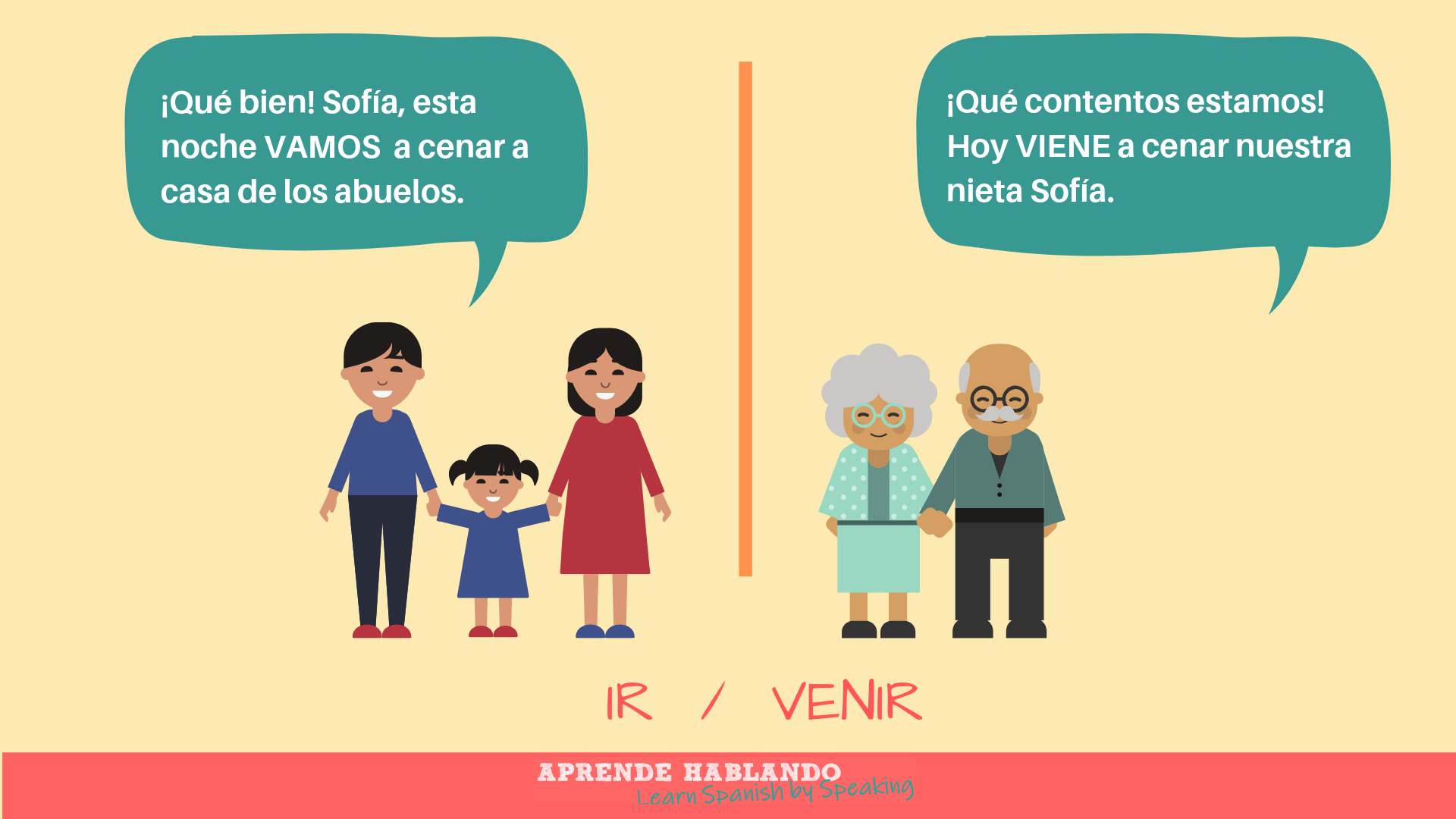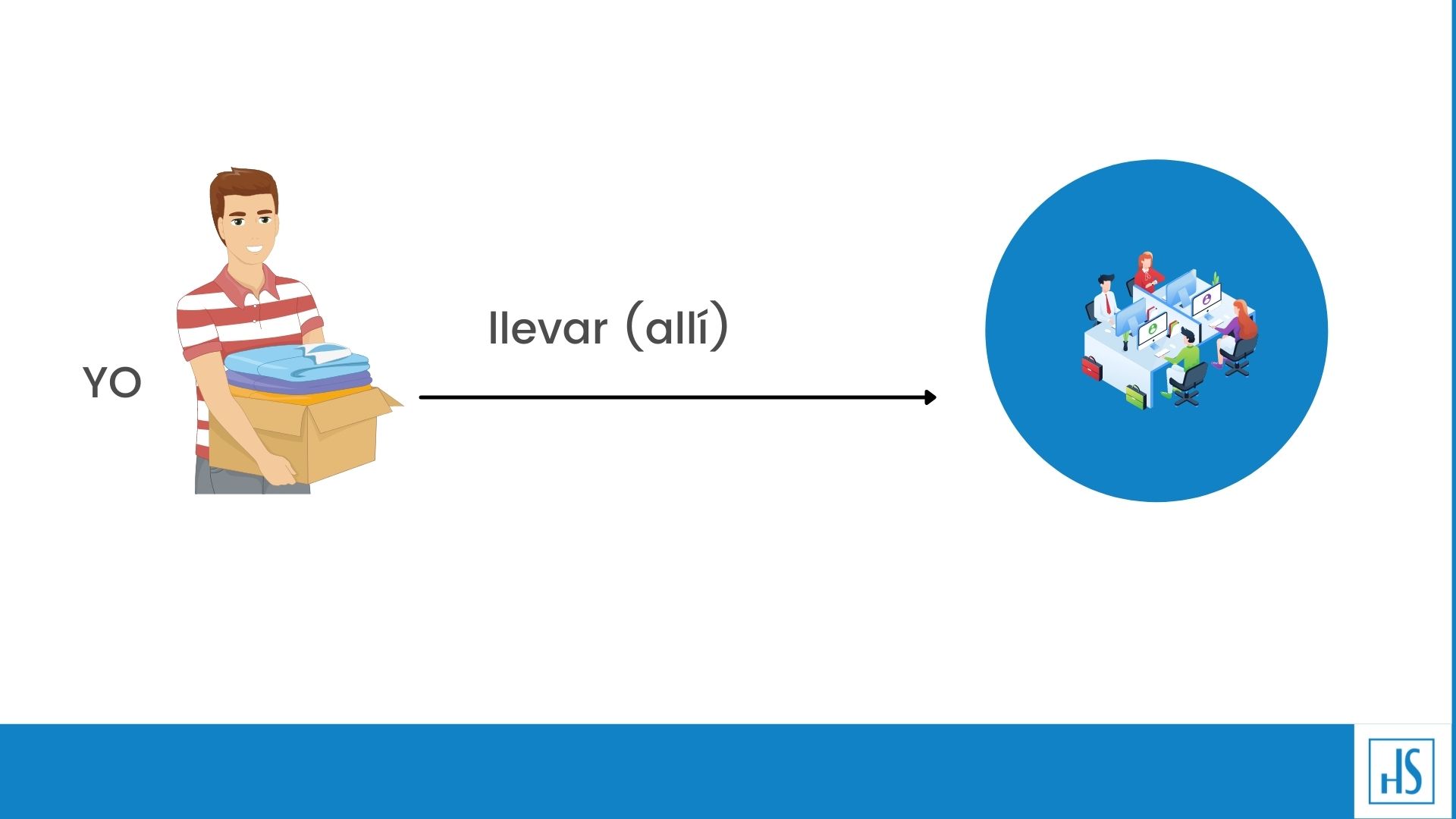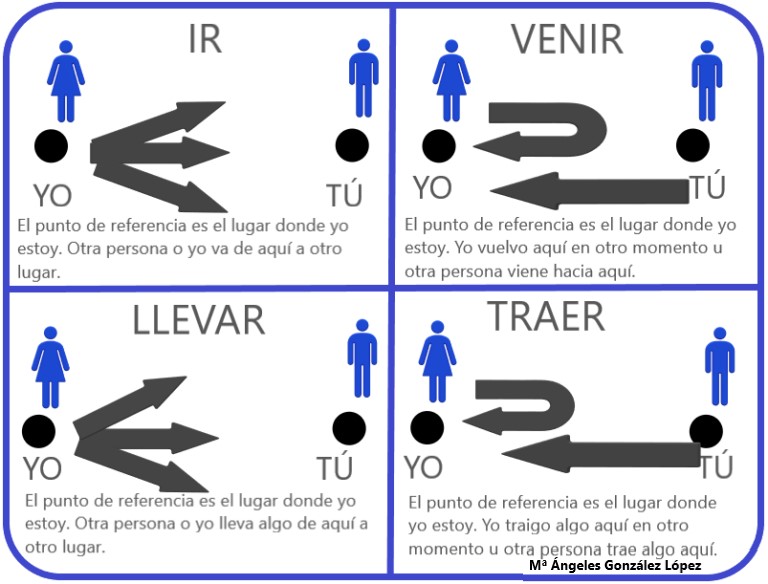
Diferencias entre IR y VENIR y LLEVAR y TRAER ProfedeELE
Llevar y traer: la diferencia Lo más importante de estos dos verbos es el punto de vista del hablante y también dónde se encuentra en el momento en el que habla. Hay una forma sencilla de diferenciar el verbo llevar y traer en español, yo siempre se la explico a mis estudiantes y funciona muy bien en casi todos los casos.

La diferencia entre llevar y traer Yourspanishguide Academia de
Traer vs Llevar are two of those Spanish verbs that many beginner students easily confuse. The confusion normally comes when you try to directly translate from English, or when two verbs have a similar meaning (e.g. Ser vs Estar or Saber vs Conocer) . The good news is that knowing when to use Traer (to bring) vs. Llevar (to take) isn't too complicated, once you understand the context in.

IR VENIR / LLEVAR TRAER Actividades para clase de español
Spanish Spanish A2 Spanish Idioms Llevar vs Traer [To Bring/To Take] [+7 Examples & Quiz] Sam Denishin July 12, 2021 In this Spanish grammar lesson, you will learn about llevar vs traer. In this lesson you will learn about: llevar vs traer how llevar vs traer are used in sentences how you can quiz yourself on llevar vs traer

Traer vs llevar en español diferencia y usos
It works together with the adverb allí (there): llevar algo allí (to take something (over) there). In sentences with llevar, the person or thing in question moves away from the speaker. Examples:

LLEVAR y TRAER La PRINCIPAL DIFERENCIA entre estos verbos
llevar - movement from here to there, away from the speaker Let's now see both of these verbs in detail. The Verb Traer - From There to Here The verb traer translates to "to bring." It means to bring something from there to here, in the direction of the speaker. If you can add the word aquí (here) and it fits, you've chosen the correct verb.

Llevar vs Traer Hola Spanish
Llevar vs Traer What is the meaning of llevar? Llevar means to take/bring something or someone from a place they are currently to a place that is far from where they are now. We can use the adverb allí or allá (there or over there). When should you use llevar? Look at this image below. In English you would say "she brings the books to the library".

LOS VERBOS IR /VENIR Y LLEVAR/TRAER Aprende Hablando
El verbo llevar funciona con el adverbio «allí»: llevar algo allí; estando el o la hablante en el punto inicial del trayecto. Ejemplo: Camarero: ¿Quiere llevar el resto a casa? Cliente: No, gracias. ¡Pero sí me llevaré una botella de este vino tan rico! traer: de allí hacia aquí

ir y venir /llevar y traer Spagnolo
The difference between llevar and traer is similar to the one between ir and venir. If you translate them literally ( to go, to come ), you won't understand why Diego says «Si vienes tú» ( if you come) instead of «Si vas tú» ( if you go ). A better approach is to think of venir (and traer) as indications that the mental location of the.

Llevar y traer 1001 Reasons To Learn Spanish
LLEVAR Y TRAER: LA DIFERENCIA CLAVE En este vídeo vemos la diferencia clave, la diferencia más importante entre llevar y traer en español. Estos dos verbos suelen causar problemas a los estudiantes porque en algunas situaciones funcionan de forma diferente a otros idioma, como el inglés, el alemán o el italiano.

Traer vs llevar en español diferencia y usos
llevar = to take (to go to someplace and carry something with you.) traer = to bring (to come to someplace and carry something with you.) Examples: Llevale estas manzanas a tu abuela. Trae unas cervezas para la fiesta de la noche. As a side note, an interesting thing is that in Japanese the corresponding verbs are made up of two verbs:

Llevar vs Traer when to use which Speakeasy
Diferencia entre LLEVAR y TRAER - Can you pass the quiz? In this lesson you'll learn Spanish verbs LLEVAR and TRAER, the key difference between both. Many st.

Llevar o traer Aprender español, Palabras en español, Vocabulario español
In this audio lesson, we practice when to use the Spanish verbs TRAER and LLEVAR. TRAER is used to say "to bring" and LLEVAR is used to say "to bring" or "to take.". Unlike their English counterparts, the Spanish verbs TRAER and LLEVAR imply a certain direction of movement. This can be a bit confusing for non-native Spanish speakers.

LOS VERBOS IR /VENIR Y LLEVAR/TRAER Aprende Hablando
Llevar y traer: la diferencia. The most important thing about these two verbs is the point of view of the speaker and also where he/she is at the moment he/she is speaking. There is a simple way to differentiate the verb llevar and traer in Spanish, I always explain it to my students and it works very well in almost all cases. I am going to.

Top 148+ Imagenes de venir Smartindustry.mx
Complete the text with the correct forms of traer or llevar. Querida prima Elisa: Estamos de vacaciones en Tenerife. En Madrid es invierno, pero aquí solo hemos ropa de verano. Daniel me ha de sorpresa para celebrar mi cumpleaños. Mañana me va a a ver el Teide. Hemos la tienda de campaña y vamos a acampar algún día en la playa.

Pin su Nivel A2
Quick Answer In Spanish, there are two verbs commonly used to say to bring: llevar and traer. There are important differences between these two verbs in terms of context. Let's learn a bit more about each one! Llevar Llevar is used when the speaker brings or takes something or someone from their current location to another location.

Aprender español Ir y venir / Llevar y traer (nivel básico) Learning
Learn the difference between LLEVAR and TRAER, two verbs of movement in Spanish that cause a bit of confusion for Spanish students who speak English.👉 Check.